

How To Harvest & Store Herbs. Most herbs for culinary use are ready to harvest just before flowers appear on the plant.

If you harvest them after the flowers appear there will be a reduction in flavor. Do not cut the herbs too close to the ground, if you leave some lower foliage you may be able to get several cuttings during the growing season. The best time of day to harvest herbs is in the early morning, just as the sun dries the dew from the leaves.
The oils are the strongest in the plants at this time. Herb Culture & Use - Virginia Coop Extension. Introduction Most botanists would define an herb as a plant that dies back to the ground each year without forming woody stem tissue.

This definition limits the number of plants technically called herbs. Most gardeners include plants that have culinary, medicinal, aromatic, or ornamental uses. This definition would include lavender, rosemary, and bay, which form woody stems. Many families in the 18th and 19th centuries had their own herb gardens. Herbs can be planted with vegetables or mixed in garden beds with annuals, perennials, shrubs, and trees. Essential Oil Recipes. How To Dry Herbs. A good spaghetti sauce or roast is never complete without a selection of tasty herbs.
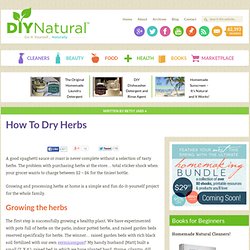
The problem with purchasing herbs at the store… total sticker shock when your grocer wants to charge between $2 – $6 for the tiniest bottle. Growing and processing herbs at home is a simple and fun do-it-yourself project for the whole family. Growing the herbs The first step is successfully growing a healthy plant. We have experimented with pots full of herbs on the patio, indoor potted herbs, and raised garden beds reserved specifically for herbs. If you cannot grow your own, you can still dry fresh herbs purchased from the store or farmer’s market. Harvesting the herbs After your plants begin growing big and sturdy you can start harvesting. I try to stay on top of my herbs each summer, periodically cutting to promote new growth, and drying it out to use until the next growing season. Drying the herbs. Make Essential Oil From Orange Peels. How to Make Homemade Peppermint Extract -Whole Natural Life.
Part of the reason that I decided to grow mint this year was so that I could try making my own peppermint extract.
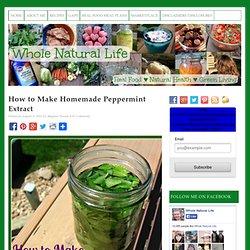
Jesse and I are pretty much obsessed with mint (especially mint plus chocolate) so we go through a lot of mint extract. Even though I buy my extracts through Azure Standard, they’re not exactly cheap, so making my own seemed like a great way to save some money. Make Your Own Witch Hazel Extract. ABC Homeopathy. How to Make a Skin-Nourishing Herbal Salve. If you have a yard, chances are you are growing the ingredients for a skin soothing herbal infusion without even trying! Plantain (Plantago major) is considered a weed, but it also contains natural constituents that are wonderful for your skin.
Violet (Viola odorata) leaves are in the same category (not to mention that the flowers are delicious in salads or syrups!). Violet is moisturizing, toning, healing, and great for sore nipples. Plantain is good for eczema, acne, minor cuts, stings, insect bites, poison ivy itch, and diaper rash. The basis of a skin-nourishing herbal salve is an herbal oil infusion. Rinse the leaves in cold water to remove any dirt, bugs, etc. Place in a single layer on a baking sheet and bake at the lowest temperature for a couple of hours, until the leaves are dry and crispy. Put the dried leaves into a glass quart-sized jar, then fill to the top with olive oil (preferably organic).
How To Make Your Own Coconut Oil! Please Share This Page: Google + stumbleupon tumblr.
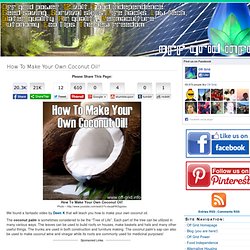
Henriette's Herbal Homepage. By Henriette >If I can get dried herb before immersing in the oil it works well. So I usually don't harvest until 2 or 3 days after a rain, because the moisture in the leaf will spoil the oil. In the Garden - Ingredients for Herbal Tea Lie Around the House. Poisonous Plants Basics. Plants are amazing creatures that produce many great benefits for human consumption.

We get most of our medicines from plants, our foods and even our beauty products. Still, there are poisonous plants among the wild edible plants that people need to be aware of when it comes to consuming them. To be responsible foragers we should have a few basic pieces of knowledge in our pockets to stay safe. By being smart about plant harvesting and consumption, we need not be scared. Poisonous Plants 1. Successful use of plants in a survival situation depends on positive identification.
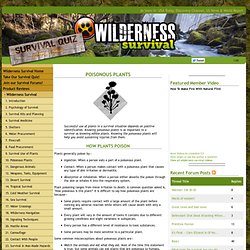
Knowing poisonous plants is as important to a survivor as knowing edible plants. Poisonous Plants 2. Plants basically poison on contact, ingestion, or by absorption or inhalation.

They cause painful skin irritations upon contact, they cause internal poisoning when eaten, and they poison through skin absorption or inhalation in respiratory system. Many edible plants have deadly relatives and look-alikes. Preparation for military missions includes learning to identify those harmful plants in the target area. Positive identification of edible plants will eliminate the danger of accidental poisoning. There is no room for experimentation where plants are concerned, especially in unfamiliar territory. Description: The castor bean is a semiwoody plant with large, alternate, starlike leaves that grows as a tree in tropical regions and as an annual in temperate regions. Uses for Peppermint Oil – Ways to Use Peppermint Oil – Essential Oils. Uses for Peppermint Oil Like many essential oils, Peppermint Oil has many uses for your health and around your home.
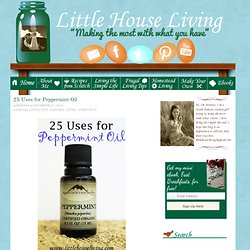
Today we will talk about a few ways to try it and make sure to share your tips on the best uses for Peppermint Oil in the comments!